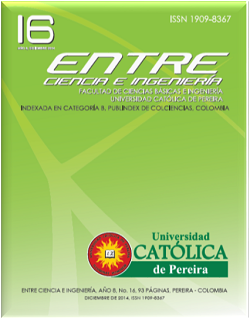Development of a biomechanical analysis software through motion capture data using the KINECT sensor for assisted rehabilitation using video games
DOI:
https://doi.org/10.31908/19098367.614Keywords:
Kinect device, Exergames, Serious Games, Euler angles, biomechanical analysis, immersive experiences, goniometric description, Monoparecia, MotoneuronsAbstract
This paper presents the potential of the Microsoft Kinect device as a tool for rehabilitation of injuries,
illnesses and injuries in the human body which allows patients to control and interact with virtual environments different applications without having to handle any gaming device and a haptic interface allowing a wireless interaction through natural user interface using gestures. All this in order to capture real-time data such as positions and Euler angles of joints normal motion and perform mobility analysis based on the Software BIOCIRAC for biomechanical analysis of movement, continuously monitor the process of rehabilitation and quantification of the results of therapy.
Downloads
References
L. J. Olaya Valencia and D. M. Sánchez Pérez, “Plan de Negocios para la creación del centro de rehabiltación Fundación Riveras,” 2012.
I. A. Isaza Velásquez, M. E. Mejía García, and A. F. Ramírez Duque, “Plan de negocios centro de rehabilitacion fisioterapeutico y kinesiologico “Fisiokine Pereira”,” 2012.
M. M. Matheus and A. R. Rincón, “La tecnología en rehabilitación: una aproximación conceptual,” Revista Ciencias de la Salud, vol. 4, 2006.
M. Shaughnessy, B. M. Resnick, and R. F. Macko, “Testing a Model of Post‐Stroke Exercise Behavior,” Rehabilitation nursing, vol. 31, pp. 15-21, 2006.
M. d. P. F. de Carrera, O. L. Contreras, E. M. Gòdia, and J. A. Montoya, “4737-1: Motion capture amb Microsoft Kinect.”
J. E. Muñoz-Cardona, O. A. Henao-Gallo, and J. F. López-Herrera, “Sistema de Rehabilitación basado en el Uso de Análisis Biomecánico y Videojuegos mediante el Sensor Kinect,” Tecno Lógicas, pp. 43- 54, 2013.
C.-Y. Chang, B. Lange, M. Zhang, S. Koenig, P. Requejo, N. Somboon, et al., “Towards pervasive physical rehabilitation using Microsoft Kinect,” in Pervasive Computing Technologies for Healthcare (PervasiveHealth), 2012 6th International Conference on, 2012, pp. 159-162.
J. C. G. Trujillo, J. E. Muñoz, and J. F. Villada, “Exergames: una herramienta tecnológica para la actividad física,” Revista Médica de Risaralda, vol. 19, 2013.
H. J. Woltring, “Representation and calculation of 3-D joint movement,” Human Movement Science, vol. 10, pp. 603-616, 1991.
E. S. Grood and W. J. Suntay, “A joint coordinate system for the clinical description of three-dimensional motions: application to the knee,” Journal of biomechanical engineering, vol. 105, pp. 136-144, 1983.
S. Schkolnik, “América Latina: la medición de la discapacidad a partir de los censos y fuentes alternativas,” Los censos de 2010 y la salud, p. 10, 2010.
A. M. R. Rincón, A. M. Cruz, L. E. R. Cheu, and J. Chaparro, “La ingeniería biomédica en Colombia: una perspectiva desde la formación del pregrado,” Revista Ingeniería Biomédica, vol. 4, pp. 23-34, 2010.






 Revista Entre Ciencia e Ingeniería
Revista Entre Ciencia e Ingeniería .png) entrecei@ucp.edu.co
entrecei@ucp.edu.co.png) ISSN (Impreso) 1909-8367 - ISSN (En Línea) 2539-4169
ISSN (Impreso) 1909-8367 - ISSN (En Línea) 2539-4169 Attribution-NonCommercial 4.0 International (CC By-NC 4.0)
Attribution-NonCommercial 4.0 International (CC By-NC 4.0)
.png) Carrera 21 No. 49-95 Av. de las Américas, Pereira, Risaralda, Colombia
Carrera 21 No. 49-95 Av. de las Américas, Pereira, Risaralda, Colombia